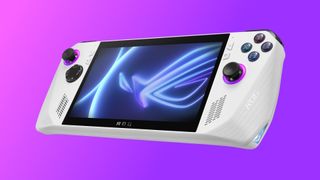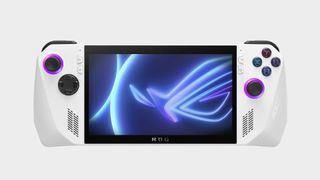Asus ROG Ally launches May 11 with pricing 'for sure... below $1,000'
Asus' Steam Deck rival is promising to redefine handheld gaming.

The Asus ROG Ally has an official launch date of May 11. That's a lot sooner than many of us expected to see the new Steam Deck rival, a wee PC that Asus is promising will "redefine handheld gaming."
The company has been seeding us with some solid data ready for its upcoming launch event, including the super-bright 120Hz 7-inch screen's response time, and the machine's confirmed pair of AMD Ryzen Z1-series chips.
After teasing the Ally on April Fools, then waiting days to reveal that it wasn't actually a joke, Asus Steam Deck rival wasn't off to the greatest of starts in the eyes of some jaded tech journalists. Asus is happy with how it all went, however, with Asus' global marketing director, Galip Fu, telling us: "We took an unconventional approach to showcase our unconventional device, and we're pleased with the results."
Not long after the initial announcement the company needled us with yet another teaser that the Ally's launch date may be "sooner than you expect", and with that coming in just a couple of weeks from now, Asus clearly wasn't messing around. This time.

APU: AMD Ryzen Z1
Lithography: 4nm
CPU uArch: Zen 4
Cores: 6
Threads: 12
GPU uArch: RDNA 3
Compute units: 4
Memory: 16GB LPDDR5
Storage: 512GB PCIe 4.0 SSD | UHS II MicroSD
Screen: 7-inch
Resolution: 1080p
Refresh rate: 120Hz
Response: 7ms
Peak luminance: 500 nits
PPI: 314
Operating system: Windows 11
Weight: 608g
Previous reports from YouTuber Dave2D placed the ROG Ally's processor as a custom AMD SoC built on TSMC's 4nm process node. Asus has now confirmed the Zen 4 CPU and an RDNA 3 GPU the Ally will be running on as a semi-custom, 6-core, 12-thread SoC known as the Ryzen Z1. It's essentially a cut down version of AMD's recent Ryzen 7 7840U mobile APU, perhaps closer to the Ryzen 5 7640U, and comes sporting a Radeon 780M GPU, just as recent leaks had hinted.
There's no word on frequency clocks, but if the recent benchmarks of the 780M iGPU are anything to go by, we're in the money. Whether the "anti-gravity heat pipes" and dual fans the ROG Ally employs will be able to keep it cool with all that power is going to be a challenge, but it looks like a big focus has been figuring out ways to improve thermals.
Asus also confirmed there is an AMD Ryzen Z1 Extreme chip—the "ultimate processor for modern handheld gaming"—which comes with eight cores and 16 threads. It also comes with three times the number of RDNA 3 compute units than the standard Z1 chip. That means you get 12 CUs as opposed to just four, and that makes a huge difference when it comes to gaming performance.
The biggest gaming news, reviews and hardware deals
Keep up to date with the most important stories and the best deals, as picked by the PC Gamer team.
If you want to talk raw GPU performance, the Z1 Extreme can manage up to 8.6 TFLOPS, which is roughly equivalent to a desktop RX 6600 GPU. The standard Z1 chip, however, is only capable of a maximum 2.8 TFLOPS, less than an RX 6400. Though that is still considerably more than the Steam Deck's 1.6 TFLOPS from its Aerith APU.
Those original 780M benchmarks came from a 12CU iGPU, so that will be the expected power of the top Z1 Extreme APU, which will surely form the basis of a second, more premium priced ROG Ally. Though might also be a bit more aggressive on the ol' battery as well as on the wallet.




An OS not historically known for being easy to use on either a touchscreen or a smol screen.
While we knew the Ally would come with a 7-inch 1080p screen, running at 120Hz, we're now being promised a healthy 7ms response time and AMD FreeSync compatibility, along with a 500 nits peak brightness. It's also sporting Corning Gorilla Glass to keep it safe and comes with DX anti-glare coating.
We're also looking at HDMI 2.0 compatibility, a swappable SSD on the PCIe 4.0 x 4 interface, and a fingerprint sensor on the wake button for a quick login. All this comes in a relatively lightweight 608g package, which Asus managed to slice down from the pre-production model's 680g thanks to new, slimmer fans and a hollowed out top case.
The Steam Deck is some 669g, which puts the Ally in a slightly lighter category.
One thing that we're still curious to see in action is just how well it works with Windows 11—an OS not historically known for being easy to use on either a touchscreen or a smol screen. Asus, however, is touting it as the easy solution to giving gamers access to "all of their publisher libraries and game streaming services on a single device."
As previously hinted, Asus is going to be adding its own game launcher to the Armoury Crate software used across the entire ROG ecosystem. The Armoury Crate SE version of the app in side the Ally is slightly different and will scan your machine for installed games and bring them all together under one unified UI. That's one way the company hopes to tackle the UI issues associated with a navigating handheld.



Asus is also promising three months of Game Pass Ultimate with each purchase, "giving users instant access to hundreds of AAA and indie titles the moment they boot their Ally." That's a pretty neat way to get people up and running quickly, and to get around the potential limitations of handheld hardware, noise, and battery life.
There has been no admission on what sort of battery life we should be able to expect out of the ROG Ally, however, and also no real hints at the final price. The closest we got was an Asus representative assuring us that, while the retail price was being held back for a reveal at the May 11 launch event (and will undoubtedly be leaked well ahead of that), "I can tell you for sure that the price will be below $1,000. 200% it will be below $1,000."
That's not 200% below $1,000 because that would mean Asus giving every customer $1,000 to take an Ally off their hands. Commercial suicide.
Still, at least it seems Asus is keen to ensure the price of the ROG Ally is roughly analogous to the mid-tier cost of a Steam Deck. Though I guess it could just end up being $999, of course.
That pricing is likely just for the base six-core edition of the Ally, however, as there is surely going to be a second, more expensive version sporting that Ryzen Z1 Extreme eight-core processor. How much more we won't know until the May 11 unveiling in a couple of weeks. But you can definitely colour us intrigued by what we've seen and heard so far.

Screw sports, Katie would rather watch Intel, AMD and Nvidia go at it. Having been obsessed with computers and graphics for three long decades, she took Game Art and Design up to Masters level at uni, and has been rambling about games, tech and science—rather sarcastically—for four years since. She can be found admiring technological advancements, scrambling for scintillating Raspberry Pi projects, preaching cybersecurity awareness, sighing over semiconductors, and gawping at the latest GPU upgrades. Right now she's waiting patiently for her chance to upload her consciousness into the cloud.
- Dave JamesEditor-in-Chief, Hardware
Most Popular







